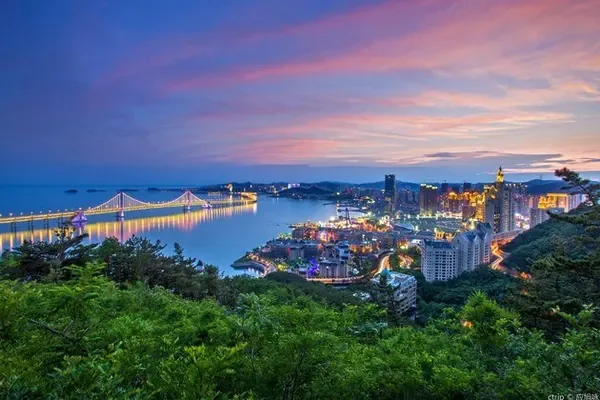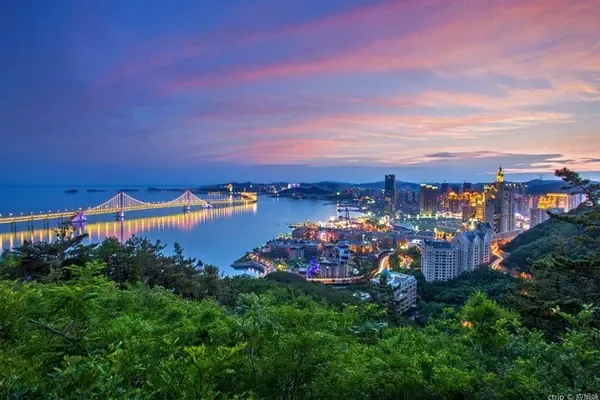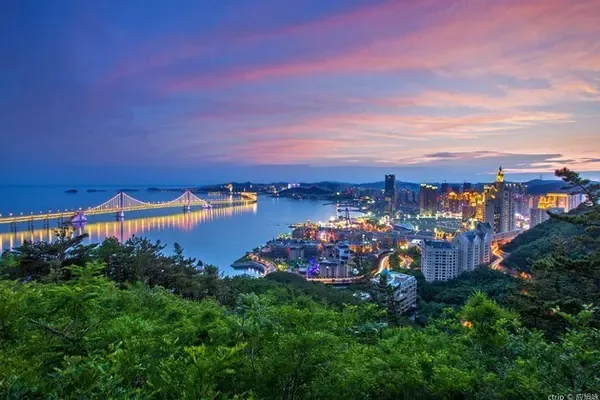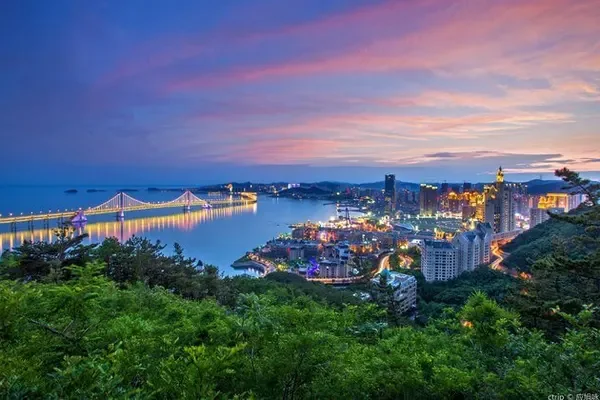The night rain is heavy, and the golden wind is finely broken, causing the leaves of the sycamore trees to turn yellow and the clouds to rise. The season just so happens that the valley is covered with autumn frost under the moon. In the early morning, the mountains are covered with mist, the dense forest is drunk red, shaking off countless melancholy, and the land as far as the eye can see is like Xiantai. The turbulent mist rolls lightly in the mountain wind and rushes past in the autumn scenery, like smoke from an incense burner. Then, I felt that illusory fog falling heavily, gathering layers on top of my head, my shoulders, and my chest, covering my body, vision, and emotions. Just in the dream, there is an illusion and mist everywhere. The sentimental autumn, in the mist of Fangshan in the west of Beijing, is branded with a little dreamy color.
Know Baihua Mountain in autumn, surrounded by clouds and mist, hazy and extremely beautiful
If you only listen to the name, you may think that there are only hundreds of flowers in "Baihua Mountain", but you don't know that there are 1,100 kinds of higher plants in Baihua Mountain, which covers an area of 21,743.1 hectares. There are 5 kinds of endemic species: Baihua Mountain Sorbus, Baihua Mountain Bupleurum, Baihua Mountain Grape, Baihua Mountain Carex, and Baihua Mountain Goose View Grass. Whenever autumn comes, when the city of Beijing is still full of greenery, it has quietly become a colorful world.
Proceeding along the winding mountain road to the top of the mountain, the winding mountain road is like a river interspersed with autumn leaves. The wheels roll up the fallen leaves scattered all over the ground and send them to the air, and the swirling air gently blows them Put it down, as if they have just left the branches of Shengqiu and can't wait to fall into the embrace of the earth.
When the gusts of wind brought back my intoxicated thoughts, the condensed mist water was like the years weaved, full and transparent. When pieces of fallen leaves are entangled under my feet, I can no longer follow the old steps, but can only continue to move forward step by step, in the spectacular scene of the dragon turning its head back and the phoenix swaying its tail, looking for the beauty hidden in the mist. When the fallen leaves dotted the blurred vision in front of me, I couldn't tell whether it was the taste of cold or the saturation of soft warmth, or looking at flowers in the fog, which is always a different kind of beauty.
Looking back and meditating, how much poetry is contained in the seasons of spring and winter. Chunhe Jingming, you and I meet with each other in a heart-warming season, and the brilliant flowers bloom in that season, crossing a foot of clear water to set off endless waves, nourishing the life waiting to bloom in the spores. The hot summer, the temperature of the mountain breeze, is enough to have an endless aftertaste, and the lingering clear silk, the affection is light and long. Autumn leaves are intoxicating, bending over to pick up a fallen leaf and twisting it lightly in the palm, who told me that "every autumn has been sad and lonely since ancient times"? I only feel that Manshan Caiyi is extraordinarily enchanting. The winter snow is covered, that is the plain clothes that wrap all the memories lightly, like a gentle fairy in the world. Walking in the Baihua Mountain, no matter who you are, you will be fascinated by it, fascinated by it, and shocked by it. The dense fog also shows the mystery of Baihua Mountain. Qiu Yun is endowed with more meanings and has more way of expression.
There is continuous drizzle at the foot of the mountain, mist in the mountains, and a sea of clouds on the top of Baihua Mountain, which is quite spectacular from the air. The radar station of North China Air Traffic Control is the landmark building of the main peak of Baihua Mountain. It stands between the sky and the earth as if it symbolizes the crystallization of human power and wisdom, and reaches the sky, which is amazing.
The building on the other side of the radar station is Xianguang Temple on the top of Baihua Mountain. The quaint buildings are inlaid among the forest leaves, and the clouds and mists are lingering, just like the heavenly palace of the Jade Emperor.
The four seasons of Baihua Mountain have its unique charm, especially in autumn. This is the best mountaineering choice for hiking enthusiasts, a creative paradise for photography enthusiasts, and an excellent "track" for self-driving enthusiasts. In the most beautiful autumn, quickly pack your bags, bring your favorite family and friends, and come to Fangshan Baihuashan National Nature Reserve to enjoy the most beautiful autumn scenery in Beijing.
Turn decay into magic, from the mine pit to the Bairui Valley of the World Forest Park
Beijing Bairuigu Scenic Area is located in Shijiaying Township, Fangshan District, east foot of Baihua, Taihang, West Taihang, with a total area of 4.9 square kilometers, an altitude of 700-1800 meters, and 85 kilometers away from downtown Beijing. Since 2011, Bairui Valley Scenic Spot has been invested and developed by private entrepreneur Zhang Jinbao, and has been rated as a "Demonstration Unit for Mine Restoration Industry Transformation" by the local government.
The scenic area has natural mountains and rivers, beautiful ecology, rich animal and plant resources, unique meteorological landscape, and profound cultural heritage. There are 7 functional areas including the Buddhist cultural area, the natural sightseeing area, the mine ecological restoration area, and the mining relics display area. With the Tianchi Lake as the center, there are two tourist routes in the east and west, connected by the Nuanwogou trail. The Ruiyun Temple in the scenic area was built in the Northern Zhou Dynasty. It has a history of more than 1,400 years and has witnessed the vicissitudes of Chinese civilization. The main attractions are Glacier Flower Sea, Baihua Spring, Tianma Grassland, Shanmen Tianchi, Jurassic Forest, high-altitude zipline, etc.
Beijing Bairuigu Natural Scenic Area is located in Caojiafang Village, Shijiaying Township, under the famous Baihua Mountain in the west of Beijing (the scenic spot project is developed according to the national 4A tourist attraction standard). The scenic spot is 850-1800 meters above sea level, with a total area of 4.9 square kilometers, adjacent to two famous scenic spots, Baihua Mountain and Shenglian Mountain. Bairui Valley is 100 kilometers away from downtown Beijing and about 75 kilometers away from the government seat of Fangshan District.
The Bairui Valley Natural Scenic Area has a unique climate. When spring and summer alternate, the unique shady environment forms a natural glacier. The ancient trees in spring, summer, autumn and winter are towering, the scenery is beautiful, flowers are everywhere, and the fragrance is tangy. The mountain springs at the glacier and flower sea are gurgling, and the spring water is clear and crystal clear, which can be directly drunk by people, so it is called "glacier flower sea".
The vegetation in the scenic area is rich, and different plants are distributed at different altitudes. Forest trees include oak forest, aspen forest, birch forest, larch, arborvitae, pentagonal maple, small-leaved white wax, clove, hexagram, sumac, etc.; the understory plants are mainly grasses, mixed with spiraea and clematis , Pulsatilla, Polygonatum, Grasshopper Legs, etc.
The Ruiyun Temple was first built in the Han Dynasty, and was rebuilt many times after the Liao Dynasty. In the Qing Dynasty, it was the Huguo Xianguang Temple. Among them, the Thousand Buddha Pavilion is a pavilion-style building with double eaves and a yellow tile roof on the hard mountain. It is 15 meters high and is very spectacular. The 10-meter-high copper-cast Buddha statue with thousands of hands and thousands of eyes is enshrined in the temple.
In 2010, Shijiaying Township completely closed the coal mines, actively developed the tourism industry, and developed and constructed the Bairui Valley Scenic Area according to the standards of the national 4A-level tourist attractions. In order to commemorate the arduous process of mining and coal mining by the mountain people, the remains of the coal mine were preserved and a coal mine exhibition hall was established. Entering the coal mine, you can experience the hard work and danger of the miners digging coal. In the exhibition hall, the tools and facilities of coal mining for hundreds of years are displayed, and the history of coal mining for hundreds of years and the changes of the times are recorded.

In the exhibition hall, a large number of miners' production and daily necessities are displayed to restore the difficult working environment and difficult living conditions of the miners. Through these exhibits, we can clearly understand how a coal miner works. With the transformation and upgrading of the energy structure, coal has been slowly replaced by other clean energy sources. At the same time, coal miners have gradually withdrawn from the stage of history. In such an exhibition hall, not only can we systematically understand the status of coal resources The process of formation, development and utilization can also provide an in-depth understanding of the work of coal miners.
In the exhibition hall, the miniature model of mining work based on some Zhenhui coal can be used to intuitively understand the entire mining process and the operation method of the mine.
In addition, Bairui Valley also has: Xiaohongshi, a rocky landscape with geological characteristics in the scenic area, which is an andesite breccia structure in volcanic rocks, which was formed during the volcanic eruption period of 160 to 136 million years. After a long geological change, it was continuously impacted by ice, snow and running water. Before the road was completed, Xiaohongshi was close to the cliff at the foot of the mountain. It once blocked the impact of huge mudslides and changed the direction of water flow, thus protecting the safety of the villages below the scenic spot. Dudu stone, this stone belongs to gravel tuff, was formed about 100 million years ago. Dudu stone is named after its shape. Although the surface is uneven, it is cute, so it is called by the villagers. White clay (talcum powder) is stored under the ground centered on doodles, which is a good material for whitewashing walls. In the ecological restoration construction, an artificial waterfall was built based on the Dudu stone for tourists to appreciate.
Dahongshi, like Xiaohongshi, belongs to andesite breccia. After ice and snow movement and long-term water flow during the Ice Age, although the stone body of Dahong Stone is covered with traces of wear and tear, it has always stood here. Now you can see the grooves on the slope of Dahongshi, which should be the scratches during the movement. Dahongshi has blocked the impact of many mudslides here, and has played a protective role in the safety of the village below. Dahongshi and Xiaohongshi are called "brother stones" together.
Yigong Pavilion was built to protect the Yigong stele. Yigong's surname is Liu and his name is Xingyi, also known as Daxing Yigong. He became a monk at the age of 7, and passed away at the age of 84, with tens of thousands of disciples. At the end of the Yuan Dynasty, Duke Daxingyi once practiced in Ruiyun Temple. After passing away, he was buried here. In order to commemorate his meritorious deeds, at the end of the Jin Dynasty and the beginning of the Yuan Dynasty (1233), Wu Tingshi, a Jinshi in Fanyang Township, Zhuojun County, wrote a tribute and wrote an article, and set up this monument for him.
The glacier flower sea, "the mountain is green in spring, and the ice on the stream has not disappeared. The flowers in the river are like a sea, and the jade dragon valley is around." Every spring, there are azaleas, lilacs, spirea, zhaoshanbai and other luxuriant mountain flowers here. Competing to open, a sea of flowers. In the blooming season, the ice waterfall with a drop of more than 200 meters in the mountain stream does not melt in May and June, and it sets off with the bright and delicate wild flowers, which is full of interest, forming the unique "glacier flower sea" landscape in the north. Baihua Spring and Baihua Mountain Spring are double springs flowing side by side. It is the highest spring in Beijing and the source of the Dashi River system. It gushes out from the crevices of the mountain rocks all year round. After testing, the mountain spring here is high-quality mountain spring water, which can be described as "after a hundred flowers turn into water, a mountain spring laughs for a hundred years".
Tianma grassland, alpine meadow landform. Because the terrain here is sunken and it is also a big wind outlet, it is not suitable for the growth of tall Qiao. Hundreds of herbaceous plants and dozens of low shrubs form the vegetation characteristics here. Among the herbal plants, rhubarb, bupleurum, and astragalus all have medicinal value. Among the dwarf shrubs, the Quercus japonica and Zhaoshanbai are also raw materials for making handicrafts.
According to legend, there is a legend between this Tianma Grassland and Matou Mountain in the west. A long time ago, outside the cloud-shrouded heaven, the sound of horseshoes approached from far away. The clouds are galloping, this is the celestial being herding horses. Tianma stepped on the auspicious clouds for a hundred miles, and galloped recklessly in the vast sea of clouds. Tianma traveled millions of miles a day without eating. In the blink of an eye, it was dusk. Attracted by a piece of heaven and earth.
There are high mountains standing straight up to the sky, but there is a vast pasture on the top of the mountain, and the celestial horses are also neighing in the wind. The celestial being understands that it seems that the horses are also attracted by this human pasture, so he flicks his sleeve robe and leads the horses down. to the world. The horses are enjoying the delicious green grass, and the celestial beings are admiring the scenery of the mortal world.
The glass stone island is made of glass materials and a special construction method, which encloses the rocks on the top of the mountain into a transparent island. The island's rocks were formed during a volcanic eruption 130 million years ago. The rock has almost kept its original color and luster, and there is a single plane facing upwards among the stone laminations. All these forms have raised a mystery for people. Standing on the island, you can enjoy the beautiful scenery around you. Especially the pictographic rocks on the mountains in the distance are even more fascinating.
Eight Scenic Spots of Gyeonggi, Shengmi Stone Pond - Shenglian Mountain
Shenglian Mountain is located in Shijiaying Township, Fangshan District, Beijing, about 90 kilometers away from Beijing City, at the foot of Baihua Mountain in the Shenglian Mountain Scenic Area. It is a large-scale tourist attraction integrating historical and cultural heritage and cultural landscape. The peaks of Shenglian Mountain are outstanding, and the peaks of Cuiwei belong to each other. Coupled with the mysterious holy water and holy rice, and excellent vegetation, it is known as "the first strange mountain in Kyoto".
Shenglian Mountain is steep, majestic and handsome, with deep valleys at the foot of the mountain, gurgling streams, high peaks and steep cliffs, dense cliffs, clouds and mist flowing on the mountain, endless changes, lush forests, towering old trees, temples, pavilions and pavilions hidden in thick shade. Between the covers, the mountain path has the characteristics of beauty, stretching and riding between ancient temples, and also concentratedly shows the characteristics of majesty, danger, mystery, beauty, and beauty. It is known as the small five mountains in the west of Beijing.
The Sacred Lotus Mountain Scenic Area takes Taihang Mountain as the vein, and was called Taishan Mountain in ancient times. Because the whole mountain resembles a lotus flower, it is called "Sacred Lotus Mountain". It was first built in the Tang Dynasty and flourished in the late Qing Dynasty. Temples were built on the cliffs, and Buddhism and Taoism were integrated, deducing unique cultural characteristics. According to records, it was hailed as one of the "Eight Scenic Spots of Gyeonggi" in the Ming Dynasty, and was destroyed by wars. In 2000, the original appearance of the relics was restored. At the same time, modern service facilities such as yurts and star hotels with different styles were built in the leisure area of the scenic spot, covering an area of 48 square kilometers. When it officially opened to the outside world on June 18, 2004, it successfully hosted the 10th Fangshan Tourism Culture Festival.
The main landscapes are Shanmen, Shenniu Ridge, Foyi Mountain, Zebra Stone, Sanpengshui, Sandalwood Tea House, Worship Platform, Jiulong Valley, Cuiping Peak, Twenty-eight Drives, Kite Turning Over, Pantao Palace, Jiulian Cave, Sanqing Hall, Guzhen Hall, Meditation Platform, Eight Immortals Cave, Tianjie, Cai Yixian’s Tomb, Li Niangzi’s House, Changchun Cave, Guandi Temple, Our Lady of Xishan, Tongtian Cave, Summer Snow View, Changxing Temple, Wanxian Cave, Shengshui Cave, Shengmi Stone Pond, Wangxiang Pavilion, Nantianmen, Baili Reclining Buddha, Holy Lotus Pagoda, Ancient Mill House, Xinglin Pagoda Courtyard, Xiaoyao Valley, Tiansheng Bridge, Yanwangye Nose, Hanging Horse Terrace, Ancient Pine, Welcome Pine Wait.
Due to the unique geographical location and comfortable microclimate of Shenglian Mountain, as well as the influence of religion and culture at that time, many dignitaries and dignitaries rushed to build houses here, including Wu Peifu, Cao Kun, Yang Xiaolou and other historical celebrities.
Nanjiao Ancient Village, the smell of fireworks in autumn
Nanjiao Village is located in Nanjiao Township, Fangshan District, southwest of Beijing, at the western foot of Dafang Mountain. It is a typical natural village in a deep mountain area, and the settlements are scattered. The village site is located in a ravine, built along the river valley. The mouth of the ravine is narrow and wide, shaped like a cellar, so it is named Nanjiao. From the Qin Dynasty to the Tang Dynasty, the Nanjiao area was the activity range of the northern minorities. During the Song and Liao Dynasties, Dafang Mountain was the boundary of the northern and southern regimes. In 1126, Jin destroyed the Northern Song Dynasty and completely controlled the Dafangshan area. At the end of the Yuan Dynasty and the beginning of the Ming Dynasty, there were many wars. To avoid the wars, refugees crossed Dafang Mountain and came to live in Nanjiao area. According to literature records and inferred from the ancient trees at the entrance of Nanjiao Village, Nanjiao Village has a history of 600-700 years and was once one of the "nine ancient towns" in Fangshan. Several large-scale immigrations in the early Ming Dynasty were the initial opportunity for the development of Nanjiao area.
Nanjiao used to be one of the four ancient commercial towns in Fangshan. The ancient Nanling commercial road passed through the township, and there was an endless stream of business travelers. Large-scale immigration has accelerated the development of the region. The ancestors opened up wasteland to build fields, planted trees and cypresses, built graves and temples, and their descendants reproduced. The real prosperous period of Nanjiao was during the Guangxu period. Due to the discovery and large-scale mining of coal resources in Dafangshan, many people came to settle here, and Nanjiao became one of the rich villages. There are many shops in the old street, and the caravans of camel coal come and go, and the cultural undertakings of Nanjiao also flourish, leaving many historical sites for later generations. Because the coal in Nanjiao is particularly high-quality, everyone within a radius of hundreds of miles is willing to use coal from Nanjiao. Therefore, from the end of Yuan Dynasty to the beginning of Ming Dynasty to the end of Qing Dynasty, Nanjiao has been in a period of rapid development. In Nanjiao Ancient Street at that time, caravans carrying coal shuttled back and forth, camel bells burst out, and it was a scene of prosperity. Gradually, the coal from Nanjiao also slowly walked out of a well-known Beijing Nanling Ancient Road; the Nanling Ancient Road also gradually achieved the glory of the commercial street of Nanjiao Ancient Town.
Walking past the thousand-year-old locust tree in the west of the village, you can see the cross-street building with peeling walls after turning the corner. In the east of the village one mile away, there is also a similar street-crossing building, and two street-crossing buildings built in key positions have become the gateways of the ancient commercial street. At the end of the Qing Dynasty, the Bureau of Renyi, which was in charge of taxation, set up a checkpoint here, and a beam of wood stopped the passing pack team to check the tax receipts one by one. Today, the weathered bluestone on the building crossing the street is uneven, and the word "Nanjiao" above the arched door opening is vaguely discernible.

There are more than 500 sets of traditional houses and more than 1,000 rooms in Nanjiao Village. The traditional resources mainly include the 1.2-kilometer-long ancient commercial street, the ruins of 36 old shops, cultural preservation units represented by the Bureau of Renyi and the Theater, and 17 Pudeng cultural relics. Folk flower fair activities. In 2016, it was selected into the fourth batch of Chinese traditional village lists. 1. The site selection of the village, the settlement environment is surrounded by mountains and rivers, the layout is strict, the history and culture have gone through vicissitudes, has a long history, and the ancient commercial street was very prosperous and prosperous.
Fancy banners, push stones, visit ancient houses, visit ancient roads, the same autumn, different experience. Why not come to Nanjiao Village for a walk and have a look. Feel the most authentic atmosphere of fireworks in ancient villages, and enjoy the most simple rural folk culture.
Tips: Baihua Mountain:
Tickets: 60 yuan, half price for student ID card and senior ID card
Parking fee: 10 yuan
Nearby accommodation and catering: Lianhua Villa, the room is about 280 yuan, reservation phone: 010-61380058
Accommodation on the top of the mountain: Baihuashan Hotel, about 350 yuan for the room
Bus routes:
Take the 917 Zhangfang Line (or 830 Fangshan Line) from the Tianqiao (or Liuli Bridge) to the Fangshan Interchange Room and get off at the Lianhua Temple on the 21st Road.
Self-driving route:
Exit of G4 Beijing-Hong Kong-Macau Expressway Dajian Road—Dajian Road—Hebei Town direction—Tuoli—Dongzhuangzi—National Highway 108 double track—Jiayukou—Baihuashan. Barry Valley:
Tickets: 80 yuan
Sightseeing car: 30 yuan (including round trip)
Parking fee: free
Scenic spot accommodation: Bairuigu Villa, about 368 yuan for a room
Catering in the scenic area: it can accommodate about 400 people for dining at the same time, including about 20 private rooms.
Holy Lotus Mountain:
Tickets: 60 yuan, half price for 60-year-olds, half-price for people over 65 with non-local hukou, free for Beijing hukou over 65
Sightseeing car 20 yuan (including round trip)
Cableway: 80 yuan for round trip, 40 yuan for one way.
There are Shenghui Hotel and Bailonghu Hotel for accommodation, and the average price is generally around 200.
Nanjiao Village: time reference, 1 day. Transportation: Take Fang 23 Road and get off at Nanjiao Xiaoxi'an Station
Tickets: Free



